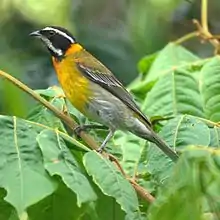Spindalis
Spindalis is a genus consisting of four non-migratory species of bird. It is the only genus in the family Spindalidae. The species are endemic to the Greater Antilles; a population on Cozumel Island, off the Yucatán Peninsula's east coast, is part of that island's West Indian fauna. The species were traditionally considered aberrant members of the tanager family Thraupidae.
| Spindalis | |
|---|---|
_male.JPG.webp) | |
| Western spindalis (Spindalis zena) | |
| Scientific classification | |
| Kingdom: | Animalia |
| Phylum: | Chordata |
| Class: | Aves |
| Order: | Passeriformes |
| Family: | Spindalidae Barker, Burns, Klicka, Lanyon, & Lovette, 2013[1] |
| Genus: | Spindalis Jardine & Selby, 1837 |
| Type species | |
| Spindalis nigricephala | |
| Species | |
|
See text | |
Males are characterized by bright plumage while females are duller and have a different coloration. The nests are cup-shaped.[2]
Species
The genus contains four species:[3]
| Male | Female | Common Name | Scientific name | Distribution |
|---|---|---|---|---|
| Hispaniolan spindalis | Spindalis dominicensis | Hispaniola (Haiti and the Dominican Republic) | ||
_(8082131069).jpg.webp) |  | Jamaican spindalis | Spindalis nigricephala | Jamaica |
 | _(5403225013).jpg.webp) | Puerto Rican spindalis | Spindalis portoricensis | Puerto Rico |
.jpg.webp) | _female.JPG.webp) | Western spindalis | Spindalis zena | southeastern Florida and the western Caribbean (Cozumel, the Cayman Islands, Cuba, the Bahamas and the Turks and Caicos Islands) |
Taxonomy
Historically, the genus consisted of a single polytypic species, Spindalis zena (with the common name of stripe-headed tanager), with eight recognized subspecies—S. z. townsendi and S. z. zena from the Bahamas, S. z. pretrei from Cuba, S. z. salvini from Grand Cayman, S. z. dominicensis from Hispaniola and Gonâve Island, S. z. portoricensis from Puerto Rico, S. z. nigreciphala from Jamaica, and S. z. benedicti from Cozumel Island. In 1997, based primarily on morphological and vocalization differences, three of the subspecies (portoricensis, dominicensis and nigricephala) were elevated to species status. S. zena remained a polytypic species with five recognized subspecies—S. z. pretrei, S. z. salvini, S. z. benedicti, S. z. townsendi, and S. z. zena.[4]
References
- Barker, F.K.; Burns, K.J.; Klicka, J.; Lanyon, S.M.; Lovette, I.J. (2013). "Going to extremes: contrasting rates of diversification in a recent radiation of New World passerine birds". Systematic Biology. 62 (2): 298–320. doi:10.1093/sysbio/sys094.
- Garrido et al. 1997, p. 587.
- Gill, Frank; Donsker, David; Rasmussen, Pamela, eds. (July 2020). "Enigmatic Oscines". IOC World Bird List Version 10.2. International Ornithologists' Union. Retrieved 18 October 2020.
- Garrido et al. 1997, pp. 588–589.
Sources
- Garrido, O.H.; Parkes, K.C.; Reynard, G.B.; Kirkconnell, A.; Sutton, R. (1997). "Taxonomy of the stripe-headed tanager, genus Spindalis (Aves:Thraupidae) of the West Indies". The Wilson Bulletin. 109 (4): 561–594.